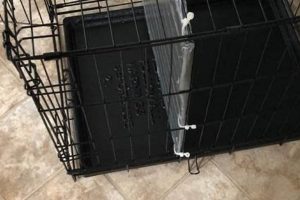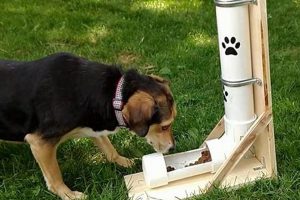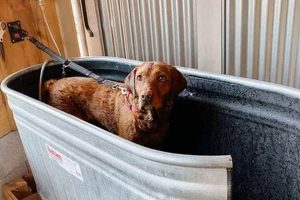The practice of constructing a restraint for a canine’s mouth at home involves using readily available materials to create a device that limits the dog’s ability to bite or bark. Examples of such constructions may include utilizing fabric, tape, or other flexible materials to fashion a temporary barrier around the dog’s snout.
This approach to canine management is sometimes seen as a cost-effective or immediate solution when a commercially produced device is unavailable. Historically, improvised methods were often the only option for restraining animals. However, it is important to recognize that proper design, fit, and material selection are critical for effectiveness and the animal’s well-being. A poorly constructed device can be ineffective, cause injury, or impede the dog’s ability to breathe, drink, or pant properly.
The following discussion will elaborate on the potential benefits and drawbacks, safety considerations, and appropriate alternatives when considering methods to safely manage a dog’s behavior in specific situations, emphasizing the importance of professional guidance and ethical treatment.
Considerations for Improvised Canine Mouth Restraints
When circumstances necessitate an immediate, temporary restraint for a dog’s mouth, careful consideration must be given to safety and efficacy. These considerations are vital to prevent harm to both the animal and individuals nearby.
Tip 1: Prioritize Professional Guidance: Before considering a temporary solution, consult with a veterinarian or certified dog trainer. They can offer advice on appropriate behavior management techniques and safe restraint methods.
Tip 2: Material Selection is Crucial: Opt for soft, breathable materials like gauze or flexible fabric. Avoid using items that could cut into the dog’s skin, such as thin wire or abrasive rope.
Tip 3: Ensure Proper Fit: The restraint should be snug enough to limit biting but loose enough to allow for panting and breathing. Monitor the dog closely for signs of distress, such as excessive panting, gagging, or blue gums.
Tip 4: Never Leave the Dog Unattended: A dog wearing an improvised restraint should always be supervised. This is crucial to ensure its safety and prevent the animal from removing or becoming entangled in the device.
Tip 5: Limit Duration of Use: An improvised restraint should only be used for a brief period until a safer, commercially produced muzzle or professional assistance becomes available. Prolonged use can cause discomfort and potentially harm the dog.
Tip 6: Positive Association: Introduce the restraint gradually and associate it with positive experiences, such as treats, to minimize stress and anxiety for the dog.
Tip 7: Recognize Breed-Specific Needs: Brachycephalic breeds (e.g., Bulldogs, Pugs) require extra caution. Their short snouts make breathing more challenging, and improvised restraints may further impede airflow.
These tips emphasize the temporary and emergency nature of such solutions. Prioritizing the dog’s well-being is paramount, and professional advice should always be sought whenever possible.
The subsequent section will delve into safer, more reliable, and humane alternatives available for managing canine behavior, focusing on preventive measures and positive reinforcement techniques.
1. Material suitability assessment
In the context of creating a temporary canine mouth restraint, the “material suitability assessment” represents a critical step that directly influences the safety and effectiveness of the finished product. A poorly chosen material can lead to a cascade of negative effects, ranging from minor discomfort to serious physical harm. For instance, using a material with insufficient give could restrict the dog’s ability to pant and regulate body temperature, potentially leading to heatstroke, particularly in warm climates. Conversely, a material that is too flimsy might be easily chewed through or torn, rendering the restraint ineffective and posing a choking hazard.
The selection process requires careful consideration of several factors: breathability, strength, flexibility, and non-toxicity. Breathable fabrics like gauze or soft cotton are generally preferred, as they allow for adequate airflow. The material must also possess sufficient tensile strength to withstand moderate pulling or pawing by the dog, but it should also be flexible enough to conform to the dog’s snout without causing undue pressure or chafing. Furthermore, the material must be non-toxic to prevent adverse reactions should the dog ingest any part of the restraint. A real-world example of the consequences of neglecting material suitability involves the use of duct tape as a restraint, which has resulted in severe skin irritation, hair loss, and even chemical burns in some canines.
Therefore, a rigorous material suitability assessment is not merely a precautionary measure but a fundamental prerequisite for ethical and responsible pet management. Failing to adequately assess material safety compromises the well-being of the animal and potentially exacerbates the underlying behavioral issues prompting the need for a restraint. While temporary solutions may be necessary in certain emergency situations, the long-term welfare of the dog dictates the adoption of safe, professionally designed alternatives and the pursuit of positive reinforcement training methodologies.
2. Proper fitting procedure
The successful application of any self-constructed canine mouth restraint hinges critically upon the “proper fitting procedure.” A poorly fitted device, regardless of the materials used, can render the attempt ineffective and potentially harmful. An overly tight fit risks restricting the animal’s ability to pant, a crucial mechanism for thermoregulation in canines, potentially leading to overheating or even respiratory distress. Conversely, a fit that is too loose allows the dog to easily remove the restraint, negating its intended purpose and potentially escalating the situation for which it was applied. A real-world consequence of improper fitting involves instances where dogs have managed to dislodge makeshift muzzles and subsequently ingested portions of the materials used in their construction, necessitating emergency veterinary intervention.
The fitting procedure necessitates a careful evaluation of the dog’s anatomy, particularly the size and shape of its snout, as well as its overall temperament and tolerance for handling. The device must be adjusted to allow sufficient room for the dog to open its mouth slightly and pant without significant obstruction. Straps or ties should be positioned to avoid pressure points, such as the bridge of the nose or the corners of the mouth, to prevent chafing and discomfort. Regular monitoring during the period of use is paramount to ensure the restraint remains properly positioned and does not cause any signs of distress. For instance, excessive pawing at the face, increased salivation, or changes in breathing patterns should be interpreted as indicators of an improper fit requiring immediate adjustment or removal of the restraint.
In summary, the “proper fitting procedure” is not merely a procedural step but a cornerstone of responsible and ethical application of temporary canine mouth restraints. Neglecting this aspect can have serious ramifications for the animal’s health and safety, undermining the intended benefits of the restraint. Consequently, individuals considering such measures must prioritize thorough understanding and meticulous execution of the fitting process, while also recognizing the limitations of improvised solutions and exploring safer, professionally designed alternatives whenever feasible. The broader context underscores the importance of proactive behavioral management and preventative measures to minimize the need for restrictive devices.
3. Airway obstruction prevention
Airway obstruction prevention is of paramount importance when considering the creation and use of any makeshift canine mouth restraint. The potential for compromised respiration necessitates careful planning and execution. A clear understanding of canine respiratory physiology is essential to mitigate risks effectively.
- Material Porosity and Breathability
The selection of materials directly impacts airflow. Dense, impermeable materials such as plastic sheeting or tightly woven fabrics restrict air passage. Porous materials like gauze or loosely woven cotton allow for better air exchange, reducing the risk of suffocation. However, these materials must still maintain sufficient structural integrity to serve their intended purpose. Real-world instances highlight the dangers of using non-breathable materials, where dogs have suffered severe respiratory distress due to inadequate airflow.
- Restraint Fit and Snout Compression
The tightness of the restraint significantly influences respiratory function. Excessive compression of the snout can collapse the nasal passages, impeding airflow. The restraint should allow sufficient room for the dog to open its mouth slightly and pant, a crucial thermoregulatory mechanism. Cases have been documented where overly tight makeshift muzzles have led to hyperthermia and subsequent organ damage. A proper fit should prioritize adequate space for unrestricted breathing.
- Monitoring and Observation Protocols
Constant monitoring is critical. Even with appropriate materials and fit, unforeseen circumstances can compromise the dog’s airway. Signs of respiratory distress include excessive panting, labored breathing, cyanosis (blue gums), and restlessness. Individuals employing temporary restraints must be vigilant in observing these signs and be prepared to immediately remove or adjust the device. Failure to observe can lead to rapid deterioration and potentially fatal outcomes.
- Consideration of Breed-Specific Anatomy
Brachycephalic breeds, such as bulldogs and pugs, possess inherent respiratory challenges due to their shortened snouts and stenotic nares. These breeds are particularly susceptible to airway obstruction when subjected to any form of mouth restraint. Extra caution is warranted when considering temporary restraints for these breeds, and alternative methods of behavior management should be prioritized. Ignoring breed-specific anatomical considerations can significantly increase the risk of respiratory complications.
These facets collectively underscore the gravity of airway obstruction prevention when dealing with improvised canine mouth restraints. The interplay between material selection, fit, monitoring, and breed-specific vulnerabilities highlights the necessity for responsible decision-making and unwavering attention to the animal’s well-being. When in doubt, professionally designed muzzles or alternative behavioral interventions should be pursued over potentially hazardous, self-made solutions.
4. Supervision essential
The dictum “Supervision essential” underscores a critical safety tenet when implementing a self-constructed canine mouth restraint. The inherent risks associated with such devices necessitate continuous oversight to mitigate potential harm to the animal. A lack of vigilant monitoring can lead to various complications, negating any perceived benefits and jeopardizing the dog’s well-being.
- Early Detection of Distress Signals
Uninterrupted supervision enables prompt identification of distress indicators that may not be immediately apparent. Subtle cues, such as changes in breathing rate, excessive salivation, or attempts to remove the restraint, can signal discomfort or airway obstruction. Without constant observation, these early warning signs may go unnoticed, potentially leading to severe consequences. Documented cases illustrate instances where delayed intervention resulted in respiratory distress and heatstroke in canines wearing improperly monitored makeshift muzzles.
- Prevention of Entanglement and Injury
Makeshift restraints, due to their improvised nature, often lack the safety features incorporated into commercially produced muzzles. Loose straps, protruding edges, or poorly secured fasteners can create entanglement hazards, particularly if the dog is left unattended. Supervision allows for immediate intervention to prevent entanglement with furniture or other objects, minimizing the risk of injury. Reports detail instances where dogs have become trapped in their DIY muzzles, causing panic, self-inflicted wounds, and even asphyxiation.
- Dynamic Adjustment and Refitting
A properly fitted restraint at one point in time may become ill-fitting due to the dog’s movements or changes in environmental conditions. Supervision enables dynamic adjustment and refitting to ensure the device remains securely in place while maintaining adequate airflow and comfort. Prolonged use without adjustments can lead to chafing, pressure sores, or airway compromise. Observations of canine behavior under restraint highlight the need for continual assessment and modification to optimize fit and prevent adverse effects.
- Immediate Response to Emergencies
Despite meticulous planning and execution, unforeseen emergencies can arise. A dog may experience an allergic reaction to the restraint material, develop a sudden respiratory issue, or exhibit unexpected behavioral changes. Supervision allows for immediate response to these emergencies, facilitating timely removal of the restraint and initiation of appropriate medical care. The absence of supervision can delay critical intervention, potentially exacerbating the situation and compromising the animal’s chances of recovery.
In conclusion, the interconnectedness of “Supervision essential” and DIY canine mouth restraint cannot be overstated. Continuous oversight serves as a critical safeguard against the inherent risks associated with improvised devices. Diligence in monitoring, adjustment, and emergency response is paramount to mitigating potential harm and upholding the ethical responsibility of ensuring the animal’s welfare. Consequently, relying solely on makeshift restraints without dedicated supervision is a practice that carries unacceptable risks and should be strongly discouraged in favor of safer, professionally designed alternatives and comprehensive behavioral management strategies.
5. Temporary solution only
The inherent limitations of self-constructed canine mouth restraints necessitate their categorization as “Temporary solution only.” This designation reflects the understanding that such devices are not intended for long-term use and should be replaced with safer, more effective alternatives as soon as reasonably possible.
- Material Degradation and Durability
Materials used in DIY muzzles, often sourced from household items, lack the durability and resistance to wear and tear found in commercially manufactured products. Exposure to moisture, chewing, or repeated use can lead to rapid degradation, compromising the integrity of the restraint. For example, fabric strips may fray and weaken, rendering the muzzle ineffective and potentially creating a choking hazard. Professional-grade muzzles employ robust materials designed to withstand sustained use without degradation.
- Ergonomic Design and Comfort
Self-made muzzles typically lack the ergonomic design features of commercially available alternatives. Ill-fitting straps, rough edges, or inadequate ventilation can cause discomfort, chafing, and skin irritation. A dog subjected to a poorly designed muzzle may experience unnecessary stress and anxiety, potentially exacerbating the behaviors the restraint is intended to address. Professional muzzles are engineered to conform to canine anatomy, minimizing discomfort and promoting acceptance.
- Limited Functionality and Safety Features
DIY muzzles often provide limited functionality compared to professional models. They may lack features such as bite-proof construction, adjustable straps for a secure fit, or emergency release mechanisms. This absence of safety features increases the risk of the dog escaping the restraint, causing injury to itself or others. Commercial muzzles are designed with specific safety features to prevent escape and minimize the risk of biting.
- Underlying Behavioral Issues
Relying solely on a temporary muzzle, whether DIY or commercially produced, fails to address the underlying behavioral issues prompting its use. The restraint merely suppresses the outward expression of unwanted behaviors without addressing the root causes. A comprehensive approach to behavior modification involves identifying triggers, implementing positive reinforcement techniques, and seeking professional guidance from a certified dog trainer or veterinary behaviorist. Addressing the underlying causes is crucial for long-term behavior change.
In summary, the classification of self-constructed canine mouth restraints as “Temporary solution only” reflects their limitations in terms of durability, comfort, functionality, safety, and effectiveness in addressing underlying behavioral problems. While such devices may serve a purpose in emergency situations, responsible pet ownership dictates the pursuit of safer, more sustainable solutions that prioritize the animal’s well-being. This includes transitioning to professionally designed muzzles and implementing comprehensive behavior modification strategies.
Frequently Asked Questions
The subsequent queries address common concerns and misconceptions surrounding the creation and use of temporary canine mouth restraints.
Question 1: What materials are deemed appropriate for constructing a temporary canine mouth restraint?
Suitable materials prioritize softness, breathability, and limited elasticity. Gauze, soft cotton fabric, or bandage wraps may be considered. Abrasive or inflexible materials, such as duct tape or wire, pose significant risk of injury and are strictly contraindicated.
Question 2: How tight should an improvised canine mouth restraint be fitted?
The restraint should be snug enough to limit biting but loose enough to allow for panting and normal respiration. The insertion of one or two fingers between the restraint and the dog’s snout serves as a general guideline.
Question 3: Are there specific breeds for which temporary canine mouth restraints are particularly risky?
Brachycephalic breeds (e.g., Bulldogs, Pugs, Boxers) are at increased risk of respiratory distress due to their inherent anatomical limitations. The use of improvised restraints on these breeds requires extreme caution and should only be considered in dire emergencies.
Question 4: For what duration can an improvised canine mouth restraint be safely used?
Such restraints are intended for short-term use only, ideally no more than a few minutes. Prolonged use can compromise the dog’s well-being and may exacerbate underlying behavioral issues.
Question 5: What are the signs of distress indicating an improperly fitted or unsafe canine mouth restraint?
Distress signals include excessive panting, labored breathing, gagging, cyanosis (blue gums), pawing at the face, and attempts to remove the restraint. Immediate removal or adjustment is warranted upon observation of these signs.
Question 6: Does the use of a canine mouth restraint address the underlying causes of aggression or unwanted biting behavior?
No. A mouth restraint merely suppresses the outward manifestation of the behavior. A comprehensive behavior modification plan, developed in consultation with a qualified professional, is essential for addressing the root causes of aggression or biting.
Temporary mouth restraints are, at best, stop-gap measures. Prioritizing professional guidance and safe, humane alternatives remains paramount.
The subsequent section will explore alternative strategies for managing canine behavior, focusing on preventative measures and positive reinforcement techniques.
DIY Muzzle Dog
This exploration has illuminated the multifaceted considerations surrounding the creation and application of a diy muzzle dog. While seemingly a readily available solution in certain circumstances, its inherent limitations and potential for harm cannot be understated. Material selection, proper fit, airway obstruction prevention, the necessity of unwavering supervision, and its strictly temporary nature constitute critical parameters that demand meticulous attention. Deviation from these parameters invites unacceptable risks to the animal’s well-being.
The information presented serves as a cautionary reminder that improvised solutions should never supersede professionally designed alternatives and comprehensive behavioral management strategies. Responsible canine guardianship necessitates a commitment to prioritizing the animal’s safety, comfort, and long-term behavioral health. Consult with qualified professionals, invest in appropriate equipment, and embrace humane training methods to ensure a positive and secure environment for both the canine and the community. This measured approach represents a commitment to responsible pet ownership and the mitigation of potential harm.







